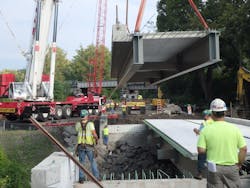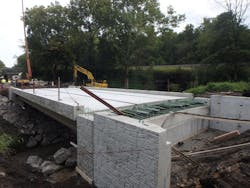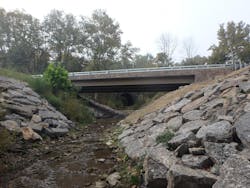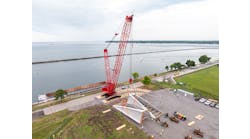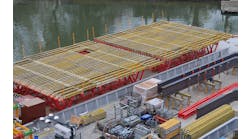By: Nikki M. Bedillion, P.E.; Contributing Author
As population density and traffic congestion, even in rural areas, continues to grow, speed and time have become primary, crucial elements of any construction project—notably bridgework, which often necessitates complicated, potentially untenable re-routing.
The Pennsylvania Department of Transportation (PennDOT) District 11-0 recently implemented prefabricated bridge elements and systems in the replacement of one of its structurally deficient bridges. Accelerated bridge construction (ABC) techniques finished the job in days instead of months.
The existing structure was a severely deteriorated concrete arch carrying S.R. 288, Main Street, over Wampum Run in Wampum Borough, Lawrence County, Pa., approximately 45 minutes northwest of Pittsburgh. The deteriorated arch provided a vital connection for residents and the trucking industry, but the failing structure had been reduced from two lanes of traffic to one bidirectional lane and would have warranted a full closure in the near future. Conventional phased construction methods for maintenance of traffic would require extensive and costly repairs to the existing arch. Meanwhile, travelers through the community would be forced to endure a 22-mile detour throughout the construction of the new bridge. Public outreach efforts identified that minimizing the time to construct the replacement structure was at the forefront of the stakeholders’ concerns.
Johnson, Mirmiran & Thompson Inc. (JMT) was challenged by District 11-0 to design a replacement structure utilizing ABC techniques with consideration to minimize disruption to the traveling public and local community. PennDOT District 11-0 chose the S.R. 288 project for its first application of ABC because of its rural location, the extensive detour and a reasonably low average daily traffic of 4,600 vehicles per day—all of which made this an ideal project for District 11-0 to assess whether ABC methods would be a feasible solution for minimizing construction durations on bridge replacements throughout the region. ABC techniques for this project site successfully resulted in a mere seven-day full road closure to construct the new bridge, greatly reducing the inconvenience to drivers.
Timely innovation
The District’s preference was to avoid both post-tensioning of the precast pieces and the use of precast deck panels; a jointless structure using integral abutments was desired. The new, 78-ft-long replacement bridge consistd of six W36 x 170 rolled steel beams supported on integral abutments. The pile caps, wingwalls, cheekwalls, backwalls, approach and sleeper slabs were designed to be precast units. The superstructure included three separate beam/deck modular units that were formed off-site utilizing conventional methods to cast reinforced concrete deck and barriers to steel beams.
Several innovative techniques were used to minimize the duration of construction activities. The precast pile caps of the integral abutments were cast with corrugated metal pipes (CMPs) to create oversized holes at the steel pile locations. By using CMPs, the contractor had more tolerance in driving the piles, and the precast pile cap was easily placed over the driven piles. The CMPs were filled with grout with a cure time of eight hours.
Prior to the installation of the precast pile cap, steel angles were welded to the steel H piles. These angles were designed to temporarily support the integral abutment pile cap and the superstructure. This support was needed to allow construction to continue while the grout cured in the CMPs. The rolled steel beams were delivered to an off-site location where the reinforcement was tied and placed for the deck and barrier. Since the District’s preference was to avoid precast deck panels, cast-in-place concrete was used. The beam/deck/barrier modules were delivered to the project site and connected using ultra high-performance concrete (UHPC).
The approach slabs were delivered to the site in three pieces. The exterior approach slabs were cast with the curb attached to the slab, to simplify installation of roadway inlets, while the precast wingwalls were cast with the PA Type 10M barrier attached.
Precast sleeper slabs and approach slabs were cast with leveling bolts and ports, so they could be placed accurately to grade. Lightweight concrete was used in the deck modules to minimize the pick weights to 118 kips. Accelerated concrete was used in the closure pour at the abutments, and an aesthetic treatment was cast to the back of the barriers, wingwalls, pile caps and cheekwalls at the precast plant.
A 3/8-in. epoxy overlay was placed over the deck and approach slabs to protect the surfaces, which also covered the inconsistencies between the precast pieces and the UHPC joints. The overlay was placed on the deck and approaches 28 days after the joints were poured as per the epoxy manufacturer’s recommendation of allowing concrete to cure for 28 days prior to its placement. The epoxy was placed during a weekend closure. UHPC was used to connect the deck modules and approach slab pieces. Known for its high compressive and tensile strengths, as well as its durability, UHPC has a compressive 28-day strength of 21 ksi and has been shown to be very durable in joints for precast members.
The final product was delivered in only seven days.
Addressing concerns
Several constructability concerns required careful consideration and planning during the design phase. Among the most notable problems with ABC projects are the tolerances with the prefabricated elements. Making sure everything “fits” together was a concern discussed during the design phase. All tolerances were clearly defined, and a final assembly plan was detailed in the final structure plans. The winning contractor team utilized this plan and (although not required by the contract documents) completed a dry-fit of all pieces prior to delivery to the project site. This extra step ensured that all pieces could be assembled without incident or delay. This extra step was a vital part of the success of this project and a lesson learned. Future projects will include a specification to the contract that instructs the contractor to complete a dry-fit with all precast pieces prior to delivery to the project site.
To ensure the S.R. 288 Bridge could be built with accessible equipment, the design team controlled the pick weights of the precast pieces and the beam/deck modules. To control the pick weights, the weight of the two-beam deck module with attached reinforced concrete deck and barrier needed to be limited; therefore, lightweight concrete was used in the deck. Even with the a lightweight concrete deck, the exterior beam/deck/barrier module weighed 118 kips. A thorough constructability analysis was conducted to ensure the modules could not only be delivered to the site but also that sufficient space was allotted for the 550-ton crane required to pick and place the modules within the limited space available.
Rolled steel beams affixed to deck/barrier panels were connected using UHPC.
A + Bx = Accepted
Step one toward a successful and cost-effective project is intelligent bidding. This project used A + Bx bidding, sometimes referred to as cost-plus-time bidding, to help ensure the contractor would build it as quickly as possible without delay. “A” is the dollar amount for the contract, “B” is the number of days to complete and “x” is the road-user liquidated damages (RULDs), thus the total bid = A + Bx. For this project, the RULDs were calculated to be $36,000/day and the number of days (B) the contractor was allowed was a maximum of 17 days and a minimum of nine days to detour traffic.
Originally, PennDOT’s main concern about ABC focused on the possibility of increased cost due to contractor risk associated with high incentives/disincentives for completion. And because of the high incentives/disincentives, the agency was concerned the number of bidders would be limited because ABC places risks onto the contractors that could potentially affect their bids. It was important that the construction schedule and sequence was clearly defined. JMT developed an hourly construction schedule and provided a construction sequence in the contract plans. Six contractors bid on the project. The winning contractor, Joseph B. Fay Co., bid nine days and completed the project in seven days, thus receiving two days of incentives equaling $72,000. Completed ahead of schedule, the project exceeded PennDOT’s expectations by meeting the original budget and falling within the average cost range of bridges in the District.
Opening Wampum Run
PennDOT’s budgeted construction cost was $2 million. The actual construction cost was $1.75 million, which included a $72,000 incentive awarded to the contractor by PennDOT for the early completion (incentive/disincentive of $36,000/day). Although the contractor received additional monies, the final average price of the structure per sq ft of deck area fell within the accustomed cost range set by District 11-0.
The S.R. 288 over Wampum Run project exceeded PennDOT’s expectations by being completed ahead of schedule, meeting the original budget and falling within the average cost range of bridges for the District. The roadway was closed on Aug. 18, 2014, and reopened to traffic on Aug. 24, 2014. The successful completion of the project was accomplished through a collaborative effort with the owner, designer and the contractor. Meetings were held both before and during construction, and these meetings quickly resolved any conflicts and discrepancies, and allowed decisions to quickly be made. These meetings proved to be a key factor in the success of this project. Based upon the success of this project, PennDOT is planning to replace more bridges utilizing ABC techniques when it is deemed necessary. Ultimately, the ABC knowledge gained from this project will be applied to future projects.
In an era when timeliness, cost concerns and traffic management are perhaps more pervasive than ever before, PennDOT may well have found a reliable, productive means to best each of those issues. R&B
About The Author: Bedillion is a senior associate with Johnson, Mirmiran & Thompson Inc.
